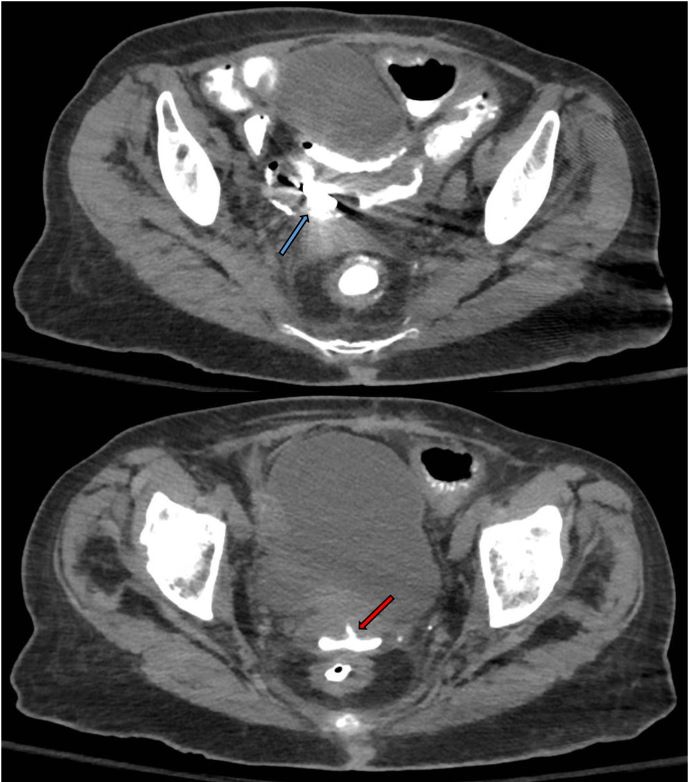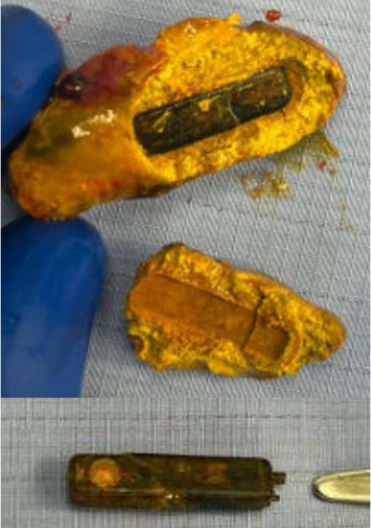Monday Poster Session
Category: Small Intestine
P4090 - Bravo’s Encore: A Delayed and Unusual Complication of Bravo pH Monitoring Capsule
Monday, October 27, 2025
10:30 AM - 4:00 PM PDT
Location: Exhibit Hall

Venkat Arutla, MD
Rochester General Hospital
Rochester, NY
Presenting Author(s)
Venkat Arutla, MD, Nathan P. Heller, MD, Erik Olson, DO
Rochester General Hospital, Rochester, NY
Introduction: The Bravo pH monitoring capsule provides clinical utility in accurately measuring esophageal pH for diagnosing conditions such as gastroesophageal reflux disease (GERD). Given the fact that the capsule is attached to the distal esophagus, complications such as odynophagia, esophageal tears, foreign body sensation, or perforation may occur. Here, we present a delayed and non-esophageal complication requiring surgical intervention.
Case Description/
Methods: A 72-year-old female with past medical history of GERD, colon cancer in remission treated with chemoradiation, Crohn’s disease in remission, cholelithiasis, small bowel obstruction, and with past surgical history of sigmoidectomy with primary colorectal anastomosis, and terminal ileum resection, presented to the hospital with persistent green/brown vaginal discharge, postprandial pain, intermittent diarrhea and unintended weight loss. The patient initially underwent computed tomography (CT) of the abdomen and pelvis, which revealed thick dilated loops of small bowel with a transition point, pneumatosis, free mesenteric air, and air within the vaginal vault. These findings raised concern for both small bowel necrosis secondary to small bowel obstruction (SBO) and an entero-vaginal fistula. The fistula was confirmed after a small bowel follow through demonstrated water-soluble enteric contrast within the vagina. The CT also showed a metallic probe within the lumen of the small bowel immediately adjacent to the fistula (Figure 1). Given these findings, the patient underwent exploratory laparotomy with entero-vaginal fistula repair and small bowel resection. Within the area of obstruction, a metallic foreign body surrounded by yellow stone-like deposit was discovered (Figure 2). The foreign body was later identified as a retained Bravo pH capsule implanted 4 years earlier.
Discussion: Bravo pH capsule complications, both non-local and delayed, are inordinately rare. This case demonstrates a rare and unexpected complication of an entero-vaginal fistula due to inflammation created by the retained capsule. The patient had known risk factors for adhesions and SBO including Crohn’s disease and more importantly multiple previous abdominal surgeries; however, the surrounding stone-like deposition around the retained capsule may have contributed as well. This case demonstrates how non-local and delayed complications with retained Bravo pH capsules can happen. It is prudent for these patients to undergo routine imaging and continued monitoring.

Figure: Figure 1: CT Abdomen and Pelvis showing metallic object (blue arrow) and enterovaginal fistula (red arrow).

Figure: Figure 2: Gross surgical specimen showing retained Bravo pH monitoring capsule.
Disclosures:
Venkat Arutla indicated no relevant financial relationships.
Nathan Heller indicated no relevant financial relationships.
Erik Olson indicated no relevant financial relationships.
Venkat Arutla, MD, Nathan P. Heller, MD, Erik Olson, DO. P4090 - Bravo’s Encore: A Delayed and Unusual Complication of Bravo pH Monitoring Capsule, ACG 2025 Annual Scientific Meeting Abstracts. Phoenix, AZ: American College of Gastroenterology.
Rochester General Hospital, Rochester, NY
Introduction: The Bravo pH monitoring capsule provides clinical utility in accurately measuring esophageal pH for diagnosing conditions such as gastroesophageal reflux disease (GERD). Given the fact that the capsule is attached to the distal esophagus, complications such as odynophagia, esophageal tears, foreign body sensation, or perforation may occur. Here, we present a delayed and non-esophageal complication requiring surgical intervention.
Case Description/
Methods: A 72-year-old female with past medical history of GERD, colon cancer in remission treated with chemoradiation, Crohn’s disease in remission, cholelithiasis, small bowel obstruction, and with past surgical history of sigmoidectomy with primary colorectal anastomosis, and terminal ileum resection, presented to the hospital with persistent green/brown vaginal discharge, postprandial pain, intermittent diarrhea and unintended weight loss. The patient initially underwent computed tomography (CT) of the abdomen and pelvis, which revealed thick dilated loops of small bowel with a transition point, pneumatosis, free mesenteric air, and air within the vaginal vault. These findings raised concern for both small bowel necrosis secondary to small bowel obstruction (SBO) and an entero-vaginal fistula. The fistula was confirmed after a small bowel follow through demonstrated water-soluble enteric contrast within the vagina. The CT also showed a metallic probe within the lumen of the small bowel immediately adjacent to the fistula (Figure 1). Given these findings, the patient underwent exploratory laparotomy with entero-vaginal fistula repair and small bowel resection. Within the area of obstruction, a metallic foreign body surrounded by yellow stone-like deposit was discovered (Figure 2). The foreign body was later identified as a retained Bravo pH capsule implanted 4 years earlier.
Discussion: Bravo pH capsule complications, both non-local and delayed, are inordinately rare. This case demonstrates a rare and unexpected complication of an entero-vaginal fistula due to inflammation created by the retained capsule. The patient had known risk factors for adhesions and SBO including Crohn’s disease and more importantly multiple previous abdominal surgeries; however, the surrounding stone-like deposition around the retained capsule may have contributed as well. This case demonstrates how non-local and delayed complications with retained Bravo pH capsules can happen. It is prudent for these patients to undergo routine imaging and continued monitoring.

Figure: Figure 1: CT Abdomen and Pelvis showing metallic object (blue arrow) and enterovaginal fistula (red arrow).

Figure: Figure 2: Gross surgical specimen showing retained Bravo pH monitoring capsule.
Disclosures:
Venkat Arutla indicated no relevant financial relationships.
Nathan Heller indicated no relevant financial relationships.
Erik Olson indicated no relevant financial relationships.
Venkat Arutla, MD, Nathan P. Heller, MD, Erik Olson, DO. P4090 - Bravo’s Encore: A Delayed and Unusual Complication of Bravo pH Monitoring Capsule, ACG 2025 Annual Scientific Meeting Abstracts. Phoenix, AZ: American College of Gastroenterology.
